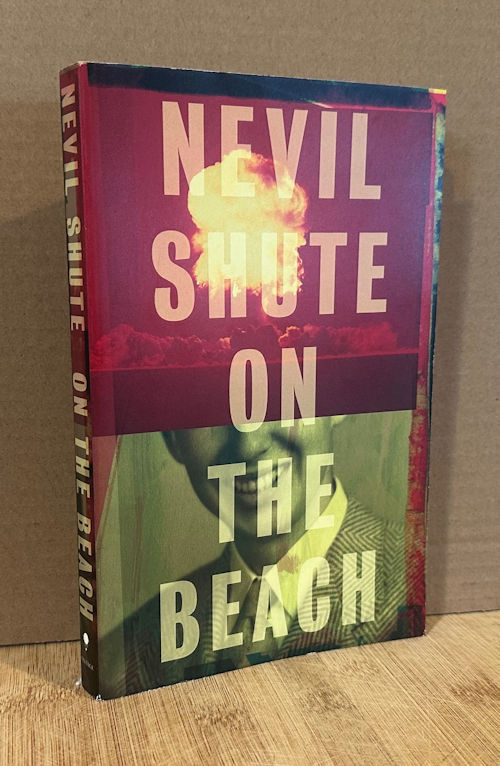(First published 1957. Edition here: Vintage International, trade paperback, February 2010, 312pp)
And here’s the next in a group of apocalyptic novels I read in June, following Butler’s PARABLE OF THE SOWER and Frank’s ALAS, BABYLON (review review here.) This is the most famous of the three, mainly because there was a fairly high-end 1959 movie based on it, starring Gregory Peck, Ava Gardner, and Fred Astaire, among others. I saw that movie long ago, though not recently; we couldn’t find it streaming anywhere (though we watched a more recent, 2000, TV version instead, which was OK.)
This has some similarities with the Frank novel, though its setting and timeline are different.
Frank’s novel began just before nuclear war broke out. This one begins some months after the war is over. Shute was an Australian author well-known, like Frank, for “mainstream” novels, though as it’s turned out each wrote a novel that came to be regarded as SF, and now those are their best-known books.
Shute sets his novel in Australia, of course, and for his nuclear war story he took advantage of its geographical circumstance: it’s in the southern hemisphere, far from where a nuclear would likely take place were it between the US and the USSR, in the northern hemisphere.
Summary
Nuclear war has been fought between the US and USSR, and possibly others, apparently wiping out the entire population of the northern hemisphere — at least, people in Australia no longer pick up any radio signals from there.
But there’s a looming threat. Clouds of radiation are gradually moving south, infecting everyone with radiation sickness along the way. No one will survive.
As in Frank’s novel, this follows several characters as they go about the daily and professional routines and interact with one another. A central character is Lt. Comm. Peter Holmes of the Royal Australian Navy. An American sub, the USS Scorpion, was at sea when the war was fought, and found refuge here in Melbourne. Holmes is recruited be on the Scorpion as it makes reconnaissance trips north, looking for survivors. There’s a signal coming in from the Seattle area, and they want to see if anyone survived up there.
There are scenes of daily life with Holmes and his wife Mary and their baby. There are scenes with Dwight Towers, commander of the sub, and a local woman he meets, Moira, who drinks heavily and loves to dance. There are scenes with Moira’s parents, out in the country.
The centerpiece of the book is the sub’s trip to Seattle — this was memorable in the 1959 film version too. They find an explanation for the erratic signal, but no one alive.
Upon the sub’s returns people settle back in routines, with that lingering time bomb. Here’s where the book gets very interesting, without overplaying it. With only weeks left, some people carry on their ordinary lives, even planning for the future, e.g. planting a tree that won’t bloom for years. Moira tries improving herself by drinking less. Others become reckless, by taking up car racing with hidden stashes of petrol; if half the racers spin off the road and die, well, they’ll all die soon enough.
For some, maintaining daily life slips into a kind of delusion. Dwight talks of taking the sub out again, and seeing his family back in Connecticut, and Moira even buys a gift for his boy. It’s a sort of cognitive dissonance — on one level they understand what will inevitably happen, and on another they want to survive by sheer force of will.
\\
That’s how the characters in Frank’s and Shute’s novels are similar: despite the worst, some of them at least are determined to maintain their lives. If only, perhaps, because they can’t think of what else to do.
\\
Without examining them closely, apparently the three versions of this story — the original novel, the 1959 movie, and the 2000 TV version, all end slightly differently. In part, they’re matters of how much each shows, rather than leaving the inevitable to the reader or viewer’s imagination.
\\
I might also remark at this point about whether books like ALAS, BABYLON or this one, or PARABLE OF THE SOWER early, are actually science fiction. None of them involve scientific discoveries or new technology, let alone spaceships or aliens or time travel. I had a friend many years ago who argued, on these grounds, that NINETEEN EIGHT-FOUR was not science fiction.
They are given a sufficient understanding of what science fiction is really about: it’s about human reaction to change. And the collapse of society, or a nuclear war, or Orwell’s totalitarian society, or Atwood’s Gilead, are changes unprecedented in human history to a degree that qualifies them as something more than just variations on human history, the way a contemporary thriller might be.






